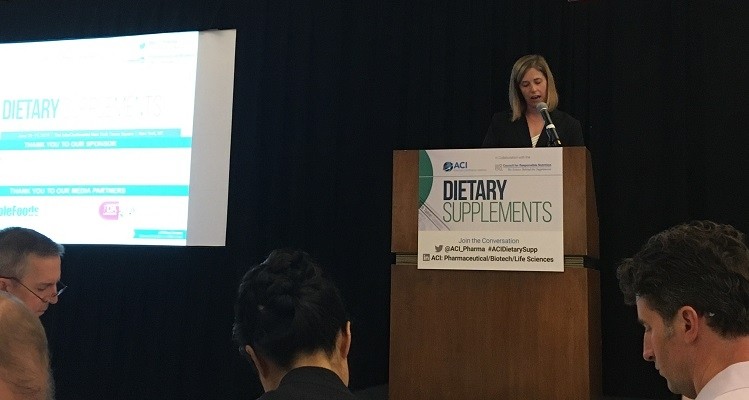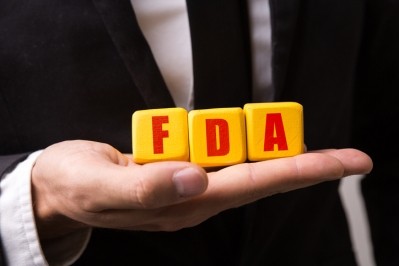FDA’s Cara Welch addresses industry, clarifies lists, stance on vinpocetine, and more

Digging through the depths of FDA’s website, one may come across a page containing bullet-pointed lists of various names for the compounds DMHA and Phenibut. One may also come across a different page titled the Dietary Supplement Ingredient Advisory List with four drop-down menus, each with its own bullet-pointed list of different chemical names.
What are the differences between these lists? This was a question posed by Paul Bolar, VP of regulatory affairs at Pharmavite, during the Q&A session after the keynote speech by FDA’s Dr Cara Welch at the ACI/CRN 7th Annual Legal, Regulatory and Compliance Forum on Dietary Supplements in New York last Tuesday.
Dr Welch is the acting special assistant to the deputy commissioner for policy, legislation, and international affairs at the FDA.
“The Dietary Supplement Ingredient Advisory list is our preliminary determination, so at that point, we won’t have necessarily finalized our determination,” she explained.
This list was first unveiled in April, and contains only four ingredients: Andarine, higenamine, hordenine, and 1,4-DMAA, each having more than one way of spelling or expressing on labels.
“It’s not product specific or firm specific, we’re only sort of weighing in on the ingredients, so it’s not a warning letter to a firm or a product-specific advisory action,” she explained. Appearing on this list means that FDA has not received or is not aware of the ingredient’s safety data. Also, manufacturers who have used ingredients placed in this list in a finished product have not received a warning letter.
“As we finalize the determination, then it will no longer fit on that list, we’ll have to move it somewhere else,” she added, though she did not specify where an ingredient will end up if it were determined that it was safe to use as a dietary ingredient.
The list was put in place to encourage stakeholders who might have information on the ingredient to share their knowledge with the FDA, potentially speeding up the determination process.
Further Reading
FDA’s new advisory list receives mixed reactions from industry
17-Apr-2019 By Adi Menayang
The Food and Drug Administration announced a new ‘rapid communication tool,’ called the Dietary Ingredient Advisory List. Trade groups and industry experts applauded the effort, but many opined that this step still has much left to be desired in terms of enforcement.
If it turns out the ingredient may not be safe, it will end up in the other lists Bolar was referring to, which have no official name, and are not organized in one section of FDA’s website either.
Instead, these lists usually appear together with an announcement of warning letters that have been sent to manufacturers who use the questionable ingredient.
“I think a great example is DMHA. When we released the dietary supplement ingredient advisory list, we also released a couple of warning letters,” Dr Welch explained. The main distinction between the advisory list and the other unnamed list of ingredients is that, for the latter, the FDA has sent warning letters or “other advisory action,” she added.
Being called-out by the FDA doesn’t necessarily mean a permanent ban either, but it does mean that its use has been deemed unlawful. “[With DMHA], there was some indication that it was a dietary ingredient, as a constituent of a botanical. If that were true, it would be a new dietary ingredient in which a notification were required [but the FDA has not received],” Dr Welch said.
Speaking of warnings… vinpocetine
Dr Welch briefly touched on FDA’s position on the cognitive health ingredient vinpocetine during her speech. The ingredient, derived from the periwinkle plant, has had a checkered history with the agency— The ingredient had five positive NDI notifications in the late 1990s, but FDA announced on September 7, 2016 that it was seeking comment on the regulatory status of the ingredient after tentatively concluding that vinpocetine is not a dietary ingredient.
Based on more than 800 comments submitted by the public on the agency’s request, it tentatively ruled that vinpocetine is not a legal dietary ingredient.
The latest vinpocetine warning, which FDA issued earlier this month, specifically targeted women who are pregnant or who are in childbearing age, “due to the possibility of miscarriage or adverse effects,” Dr Welch said.
This recent warning is based on a National Toxicology Program report on vinpocetine in rats and rabbits, yet to undergo final peer review.
FDA’s warning advised women to not take products with vinpocetine, and advised firms who firms who are making products containing vinpocetine to ensure it provides appropriate safety warnings on its labeling against use by women who are will become pregnant.
The agency’s decision on vinpocetine, however, is still not final.
“We intend to expedite the completion of this administrative proceeding, hopefully issuing something later this year,” Dr Welch said.
“That said, we didn’t feel we could wait that time to communicate about the safety concerns associated with this ingredient until the administrative position was issued, so we felt it important to issue the safety warning now.”
What does the FDA think about a mandatory product registry?
When it comes to modernizing DSHEA—the set of rules regulating the dietary supplements industry—Dr Welch said, “the FDA is fully committed to using our existing resources and programs, but we see a value in a broader conversation about whether certain changes might be helpful.”
She reminded the audience about the latest FDA budget request, submitted in March this year, which included language for mandatory premarket product registration.
“A mandatory product listing system could help to address many of the problems facing this industry, it won’t fix everything of course, we’re not that many, but done correctly, we believe it’s the right direction,” she said.
“The way I see it—a product listing program collecting even the most basic information will enable the FDA to identify and act against illegitimate interests and identify illegal new products more quickly by the simple fact of getting us past the simple barrier of even knowing that these products exist.”
Read more
The case for mandatory product listing, and the arguments against it
19-Jun-2019 By Adi Menayang
Controversy swirls around whether dietary supplement brands should be required to register the products they have on the market with FDA. Two attorneys debated the risks and benefits of a mandatory product registry yesterday at the CRN/ACI Annual Legal, Regulatory and Compliance Forum on Dietary Supplements. READ MORE










